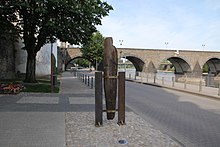Roman bridges in Koblenz
Roman bridges in Koblenz were built over the Rhine and Moselle after the Confluentes branch was founded. They were pile yoke bridges and were destroyed at the latest with the withdrawal of the Roman troops in the 5th century. The Rhine bridge made it possible to support the Roman troops on the right bank of the Rhine and the Moselle bridge was part of the Roman Rhine Valley Road .

Roman pile bridge over the Rhine
Very early on, based on various remains of piles in the Rhine, the assumption arose that a bridge crossing between Koblenz and Ehrenbreitstein had been built in Roman times . The Kapuzinergrund, a former shoal in the Rhine at this point, seemed to be ideal for building a bridge. This shoal was leveled in the 19th century to improve the navigation channel. In the process, wooden piles that had been driven into the Rhine floor were found and lifted. This collection of piles was the remains of a bridge yoke. The occasional assumption that it is about Gaius Iulius Caesar's Rhine bridge , which is located near Neuwied but could never be proven, is refuted by the particular constellation in which the wooden piles were arranged, as they are not included in the traditional descriptions the Caesarian Rhine bridge fits.
In the 1st century there were armed conflicts between Germanic tribes and the Romans. As a result , many troops were gathered in the Roman auxiliary camp in Koblenz. The exact construction time of the bridge construction is open, but it was probably built for the supply of the troops on the right bank of the Rhine.
The Rhine bridge was 350–370 m long, 8.5 m high and was built from oak trunks. It took about 650–750 trunks to build the bridge. The piles in the Rheinboden were equipped with iron spikes, so-called pile shoes . 51 of these piles are still preserved today. The felling date of the oak logs could be dated to AD 49.
After the Limes was completed in the 2nd century, the pile bridge over the Rhine lost its importance. It is not known exactly when the bridge was finally abandoned. Presumably it was destroyed with the abandonment of the Limes and Niederberg Fort in the 3rd century.
Roman pile bridge over the Moselle
The exact construction time for a pile bridge over the Moselle cannot be determined. Coin finds from the time of Claudius Gothicus (268–270) to Arcadius (395–408) are considered evidence that the bridge already existed in the 3rd century. In the years between 1860 and 1867, remnants of the pile bridge from Roman times were discovered 50 m downstream next to the Balduin Bridge . During dredging work to expand the shipping channel in 1944 and to build the Koblenz barrage in the course of the Moselle canalization 1958–1964, numerous remains of the bridge were removed from the river bed.
It is certain that the Koblenz auxiliary camp already existed around the middle of the 1st century, with the completion of the Roman Rhine Valley Road . The earth fort in Koblenz served to secure this road and the river crossing over the Moselle. It can be assumed that a bridge over the Moselle already existed. It is also considered certain that this pile bridge was destroyed when the Romans left in the 5th century. Until the Balduin Bridge was built in the 14th century, there was no fixed passage over the Moselle.
See also
- History of the city of Koblenz
- List of crossings over the Rhine and Moselle in Koblenz
- List of Rhine bridges
- List of Moselle bridges
- List of Roman bridges
literature
- Energieversorgung Mittelrhein GmbH (ed.): History of the city of Koblenz . Overall editing: Ingrid Bátori in conjunction with Dieter Kerber and Hans Josef Schmidt
- Volume 1: From the beginning to the end of the electoral era . Theiss, Stuttgart 1992, ISBN 3-8062-0876-X .
- Volume 2: From the French city to the present . Theiss, Stuttgart 1993, ISBN 3-8062-1036-5 .
- Hans Bellinghausen , Ernst Bitzegeio, Ulrich Finsterwalder : New Moselle Bridge Koblenz. Festschrift for the inauguration and handover of the New Moselle Bridge Koblenz on July 24, 1954 (extended special print from Der Bauingenieur , Volume 29, 1954, Issue 8), Springer-Verlag, Berlin / Heidelberg 1954, ISBN 3-5400-1833-6 (online)
- City of Koblenz: Koblenz City of Bridges Documentation for the inauguration of the Koblenz Balduin Bridge, Koblenz, August 1975.
- Roman Rhine Bridge Koblenz , Horst Fehr, State Office for Monument Preservation, Bonner Jahrbuch 181, 288–354; at the same time 'Archeology on the Middle Rhine and Moselle' Vol. 2, 1981
Web links
- Roman Rhine Bridge PDF file
- Entry on the Roman pile bridge over the Rhine near Koblenz in the " KuLaDig " database of the Rhineland Regional Council
Individual evidence
- ↑ Hansjörg Groenert: ( Page no longer available , search in web archives: The Roman Rhine Bridge near Koblenz )